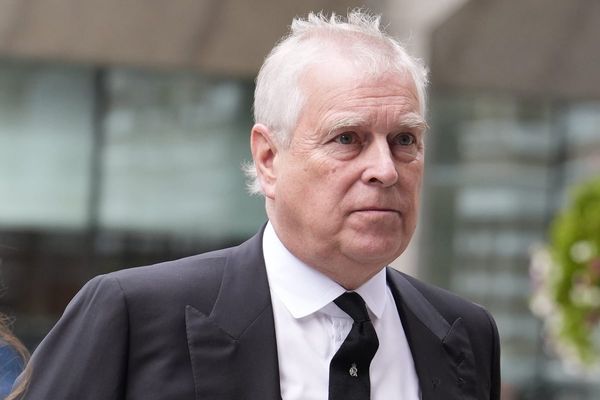
You walk into the space, and wow. The vast height of the ceiling, painted like a summer sky; the giant stone columns; the tall gothic windows, Saint George in stained glass, memorial plaques, wooden pews and other trappings of a centuries-old church, some of which dates back to 1147.
But there’s also the boho chic, the velvet sofas and Turkish rugs, a giant infinity symbol suspended from the ceiling that was made by set-builders from Glastonbury festival, and dancers lying on the floor, taking advantage of the underfloor heating to warm their muscles. In the centre, a stage, with dancers from the company Impermanence rehearsing for their show Venus, enacting the story of suffragette-turned-fascist Mary Richardson. Many eras and strands of culture colliding at once.
Until recently this church, the Mount Without, at the top of Bristol’s Christmas Steps, was left empty by dwindling congregations. But now Impermanence’s co-directors, Josh Ben-Tovim and Roseanna Anderson, are presenting a regular programme of performances here.

It came about through serendipity and really hard work. In 2012, local businessman Norman Routledge bought a dilapidated mansion, Kings Weston House, on the outskirts of Bristol. Ben-Tovim and Anderson were looking for a place to rehearse, and also to live. “We drove up in our car and walked into this incredible ballroom,” remembers Anderson. Soon they had agreed a month-long artists’ residency, with 20 artists, poets, musicians and dancers. The grounds are a popular dog-walking spot, so every day at two o’clock they’d put a sign outside and share what they’d been doing – “improvising to Chopin or whatever we were working on that day” – and a handful of people would stop and watch.
Routledge came and it reduced him to tears. “He didn’t have much of a relationship to the arts before that,” says Anderson. Six months later they moved into the house with their three-year-old son and 18 other people in what sounds like a happy commune. They lived there for five years while the house was gradually renovated and moved out when it was sold, but Routledge was keen to get involved in a new project with Impermanence and knew about the Mount Without. The church had been bombed and badly fire-damaged (destroying part of the roof), but it’s now had an impressive renovation, Ben-Tovim getting his hands dirty lugging rubble from the crypt, which has been turned into an atmospheric bar – the building’s hired out half the time for weddings and events.
It’s surprising that a city like Bristol, known for its arty vibes didn’t have a focal point for dance already. Until 2016 there was the community-run Bristol Dance Centre in an old public baths – “sometimes 100 people would be in a class,” recalls Anderson – but they couldn’t raise enough money to maintain the building. Routledge and Impermanence tried to get the lease for the baths, but it was given to a leisure centre, who recently handed back the keys having done nothing with it.
As you might expect in a city with a strong underground music and graffiti culture, there’s a longstanding hip-hop dance scene. They’re used to being DIY, says local breaker Olivia Daniell, explaining how her crew would busk on the streets to raise funds to get to competitions (the fact they managed to cover flights to Europe with their takings suggests there’s definitely an enthusiastic audience). “Bristol’s got some amazing dancers,” Daniell says, “what’s really lacking is a central space.” She teaches, but has often had to move to new venues when rent goes up. “Hamilton House was another creative hub – African dance, Bollywood, all sorts of things.” The community organisation that ran it were evicted (“There were protests on the streets,” remembers Daniell) and it’s now mostly focused on co-working. The official, Arts Council England-funded hub for dance in the south-west is in Bournemouth, but the region receives notably less public funding than others. For 2023-26, dance in the south-west will get £1.4m compared with £4.8m for the south-east, £14.3m for the Midlands and £18.5m for London.

The Mount Without is not going to be a training studio, or a stage for every dancer in Bristol, but it should be hive of creativity. Impermanence have so far welcomed about 15 artists to work or perform there. The ambition is to have a different company doing a week-long run each month, as well as scratch nights, community projects and cabarets. And although these centuries-old stone walls feel like a very solid achievement, raising funds to put on shows and fit out the space still feels precarious.
It will happen, Ben-Tovim says, determinedly. It’s just whether they’ll have a proper staircase to the lights, or the ladder they’ve got now; will they have the current lighting rig that was thrown away by another theatre, or something higher spec? The space itself is inspiring them to keep going. “I’ve been able to keep re-energising myself through the experiences of people coming and enjoying it,” says Anderson. For all of the hustle, hard graft and the constant funding applications, “it feels important to do it,” says Ben-Tovim – “come hell or high water”.
Impermanence’s Venus is at Wilton’s Music Hall, London, 17-18 May







